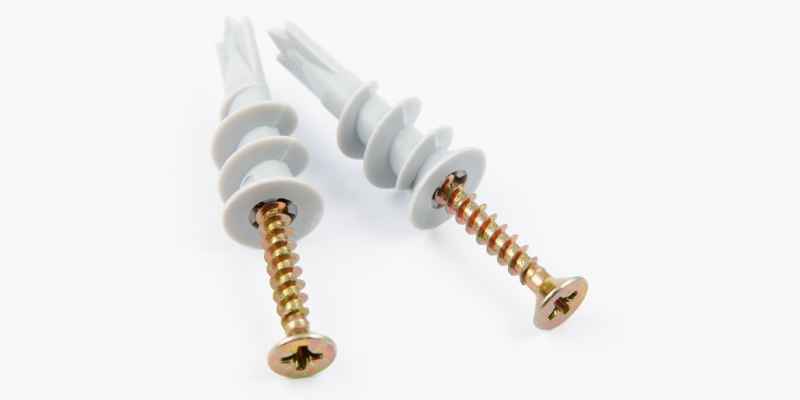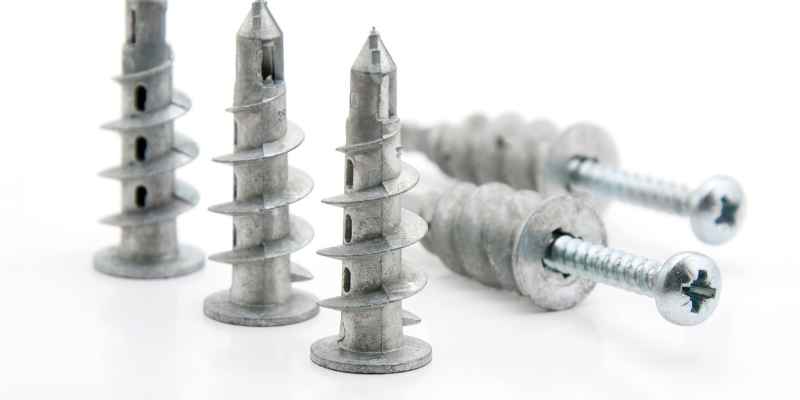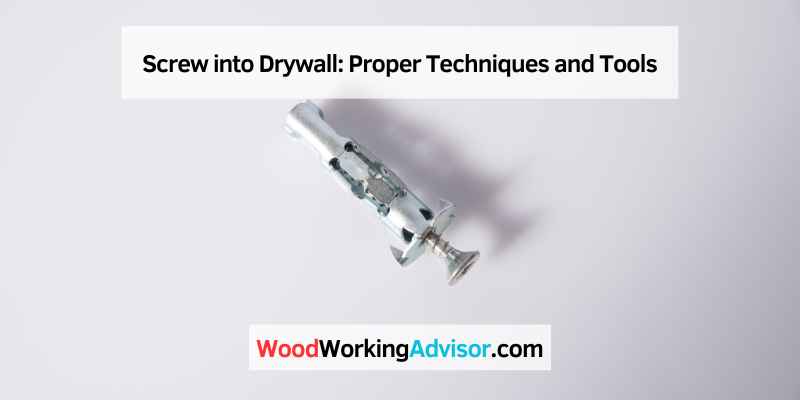When putting screws into drywall, it’s important to use caution and possibly install drywall anchors instead. Pilot holes may need to be drilled beforehand to prevent damaging the wall.
Drywall anchors provide a sturdier hold and prevent the screws from directly damaging the drywall. However, choosing the right anchor for the weight of the object being hung is important to ensure it can hold up properly. It’s also crucial to correctly install the anchor to ensure it does its job effectively.
In combination with screws, drywall anchors provide a reliable way to hang objects on a wall without the risk of damaging the drywall.
Screwing Directly Into Drywall
When screwing directly into drywall, it’s important to drill pilot holes to prevent cracking. However, using drywall anchors is recommended for heavier objects. Drywall anchors distribute the weight across a wider area and prevent damage to the drywall.
Screwing directly into drywall can give you a headache, or it can be the easiest task you perform all day. It all depends on how you approach it. In this section, we will discuss the key aspects of screwing directly into drywall. We will cover when it is appropriate, preparation, technique, and troubleshooting. Keep reading to learn more about screwing directly into drywall.
When Is It Appropriate
Before screwing anything into drywall, it’s important to know when it’s appropriate to do so. Generally, it’s best to use drywall anchors when mounting anything that weighs more than a few pounds. However, if you’re mounting something that is lightweight, it may be okay to screw directly into the drywall. Always consider the weight of the item you plan on mounting before screwing it directly into the drywall.
Preparation
Preparation is key when screwing into drywall. First, mark the location where you want to place the screw. Use a stud finder to ensure that you’re not drilling into a stud if you plan to place weight on it. Once you’ve marked the location, drill a small pilot hole. This will prevent the drywall from cracking when you start to screw it in. It’s also important to select the right size and length of the screw, as using the wrong one may make it hard to insert or cause damage to the drywall.
Technique
When screwing directly into drywall, it’s important to keep a few things in mind. Firstly, make sure the screw is going in straight and perpendicular to the wall. This will help to avoid stripping the drywall. Additionally, avoid over-tightening the screw, as this can also cause the drywall to crack. Finally, ensure that the screw head sits flush with the surface of the drywall.
Troubleshooting
If you encounter any problems when screwing directly into drywall, don’t panic. A common issue is that the screw won’t insert properly or falls out. If this happens, check the size of the screw and the size of the hole in the drywall. Using a larger screw or making the hole larger may do the trick. If the drywall is still not holding the screw, consider using a drywall anchor instead.
In summary, screwing directly into drywall can be a simple task when done correctly. Always consider the weight of the item you plan to mount, drill a pilot hole, use the right size and length of screw, and insert the screw perpendicular to the wall. If you encounter any issues, consider using a drywall anchor instead.

Using Drywall Anchors
When screwing into drywall, it is important to use drywall anchors instead of directly inserting screws into the wall. Drywall anchors, such as toggler snaptoggle or Hillman hollow wall anchors, distribute the weight of the object evenly and prevent damage to the wall.
Proper installation involves drilling a hole, inserting the anchor, and then screwing into the anchor, as explained in detail by home improvement experts on YouTube and DIY blogs.
When it comes to hanging items on your wall, putting screws directly into drywall is not recommended. This is because drywall is not strong enough to hold heavy objects and the screws can easily pull out, leaving unsightly holes. Instead, using drywall anchors is the best solution. Drywall anchors are small plastic or metal devices that are inserted into the drywall to provide extra support for the screws. In this article, we will discuss when to use drywall anchors, the different types of drywall anchors available, preparation and technique, and the benefits of using drywall anchors.
When to use drywall anchors
It’s important to use drywall anchors when hanging anything on your wall that is heavier than a picture frame or clock. These can include shelves, mirrors, and even light fixtures. If you’re unsure whether an object is too heavy for your drywall, it’s always best to err on the side of caution and use a drywall anchor.
Types of drywall anchors
There are various types of drywall anchors available, including plastic expansion anchors and toggle bolts. Plastic anchors are ideal for lightweight items, whereas toggle bolts are better suited for heavier items. There are also self-drilling anchors that don’t require pre-drilled holes, making them easier to install.
Preparation
Before installing a drywall anchor, it’s important to prepare the area first. Make sure to find a suitable spot to hang the object by using a stud finder or tapping on the wall to locate a solid area. Once you’ve found the right spot, mark it with a pencil and then proceed to install the anchor.
Technique
Inserting a drywall anchor is a simple process. First, drill a small hole in the drywall where you’ve marked the spot. Next, insert the anchor into the hole and then screw in the screw until it’s snug but not overly tight. If you’re using a toggle bolt, make sure to follow the manufacturer’s instructions for insertion.
Benefits of using drywall anchors
Using drywall anchors provides several benefits, including increased weight capacity for hanging items, reduced risk of damaging the drywall, and easier installation. With drywall anchors, you can rest assured that your items are securely hung and won’t fall off the wall.
In conclusion, using drywall anchors is an easy and efficient way to hang heavier items on your drywall. By choosing the right type of anchor and properly preparing the area, you can ensure that your items are securely fastened to the wall.

Alternative Methods
Finding a suitable method to screw into drywall securely can be a challenge, especially when studs are not conveniently located. Fortunately, there are alternative methods available for anchoring screws into drywall effectively. These alternative methods provide solutions for hanging heavier objects or equipment where standard screwing may not deliver the required support.
Creating Stud Anchors
When the option to screw directly into a stud is not feasible, creating stud anchors can provide a solution for securing heavier items to the drywall. By using a piece of wood and attaching it horizontally or vertically across the studs, a secure anchor is formed for inserting screws. This helps distribute the weight of the hung item more evenly and reduces the risk of damaging the drywall.
Using Adhesive Strips
Adhesive strips offer a convenient and simple alternative for securing lightweight items onto drywall without the need for drilling or hardware. These strips provide an effective solution for temporary or lightweight fixtures and can be removed without causing damage to the drywall surface. It is important to check the weight limits of the adhesive strips before use to ensure they can adequately support the intended item.
Using Toggle Bolts
Toggle bolts offer a reliable alternative for hanging heavier objects on drywall where standard screws may not provide sufficient support. These bolts feature a spring-loaded wing design that expands behind the wall, creating a secure anchor point for the screw. Utilizing toggle bolts ensures a strong and durable attachment to the drywall, making them an effective alternative for anchoring heavier items with confidence.
Frequently Asked Questions For Screw Into Drywall
Can I Put A Screw Directly Into Drywall?
You should not put a screw directly into drywall. You might need to drill pilot holes beforehand. It is recommended to use drywall anchors for securing an object to the wall. With drywall anchors, you won’t insert the screws directly into the wall.
This ensures a secure hold.
How Do You Screw In Drywall?
To screw in drywall, start by drilling a hole in the drywall the same size as the anchor you will use. Then gently insert the anchor until it is embedded in the wall. Finally, screw in the screw the rest of the way into the anchor.
Avoid putting screws directly into drywall and use anchors instead.
Can You Use Regular Screws In Drywall?
No, you cannot use regular screws in drywall. Wood screws are not designed for drywall and won’t hold properly. Instead, use drywall anchors to secure objects to the wall. Drill a hole in the drywall, insert the anchor, and then screw in as far as needed to hang items.
How Do You Screw Into Drywall Without Studs?
To screw into drywall without studs, use a drywall anchor instead. Drill a hole in the drywall, insert the anchor, and tap it gently until it is embedded in the wall. Then, drive the screw into the anchor and tighten as needed.
Avoid putting screws directly into drywall, as it won’t hold properly. Use a hollow wall anchor for better results.
Conclusion
Screwing into drywall doesn’t always provide the best results. Using drywall anchors can provide more stability and prevent damage to your walls. By following the tips and tricks outlined in this post, you can successfully screw into drywall using drywall anchors.
Make sure to choose the appropriate anchor based on the weight of the item you’re hanging and the type of drywall you have. With these steps, you can confidently hang your items without worrying about damaging your walls.


